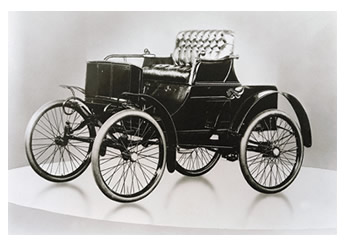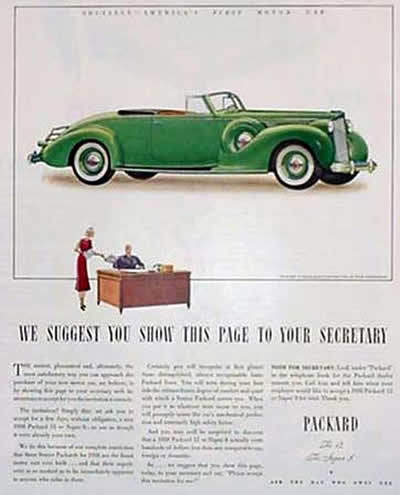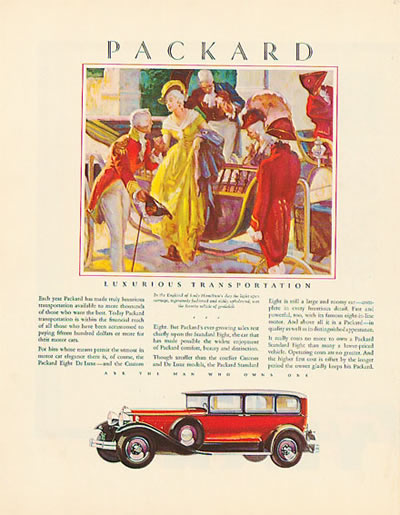 |
 All Classic Ads Vintage Collection - Packard related ads All Classic Ads Vintage Collection - Packard related ads
1930 Packard Ad • 1938 Packard Convertible Ad
 History of Packard (1899) History of Packard (1899)
Packard was an American luxury automobile marque built by the Packard Motor Car Company of Detroit, Michigan, and later by the Studebaker-Packard Corporation of South Bend, Indiana. The first Packard automobiles were produced in 1899 and the last in 1958.
Packard was founded by James Ward Packard , William Doud Packard and his partner, George Lewis Weiss, in the city of Warren, Ohio. James Ward believed that they could build a better horseless carriage than the Winton cars owned by Weiss (an important Winton stockholder) and, being himself a mechanical engineer, had some ideas for improvement on the designs of current automobiles.
|
|

By 1899, they were building vehicles. The company, which they called the Ohio Automobile Company, quickly introduced a number of innovations in its designs, including the modern steering wheel and, years later, the first production 12-cylinder engine.
While the Cole 30 and Colt Runabout were US $1500, the high-volume Oldsmobile Runabout went for US$650, Western's Gale Model A roadster was US$500, and the Black went as low as $375, the Packards concentrated on cars with prices starting at $2,600. Packard automobiles developed a following among wealthy purchasers both in the United States and abroad.
Henry Bourne Joy, a member of one of Detroit's oldest and wealthiest families, bought a Packard. Impressed by its reliability, he visited the Packards and soon enlisted a group of investors—including Truman Handy Newberry and Russell A. Alger Jr. On October 2, 1902, this group refinanced and renamed the New York and Ohio Automobile Company as "Packard Motor Car Company", with James as president. Alger later served as vice-president. Packard moved its automobile operation to Detroit soon after, and Joy became general manager, later to be chairman of the board. An original Packard, reputedly the first manufactured, was donated by a grateful James Packard to his alma mater, Lehigh University, and is preserved there in the Packard Laboratory. Another is on display at the Packard Museum in Warren, Ohio.
The 3.5 million ft2 (325,000 m²) Packard plant on East Grand Boulevard in Detroit covered over 35 acres (142,000 m²). It was designed by Albert Kahn, and included the first use of reinforced concrete for industrial construction in Detroit. When opened in 1903, it was considered the most modern automobile manufacturing facility in the world, and its skilled craftsmen practised over eighty trades. The dilapidated plant still stands.Architect Kahn also designed The Packard Proving Grounds at Utica, Michigan.
From this beginning, through and beyond the 1930s, Packard-built vehicles were perceived as very competitive in the class of high-priced luxury American automobiles. The company was commonly referred to as being one of the "Three P's" of American motordom royalty, along with Pierce-Arrow of Buffalo, New York and Peerless of Cleveland, Ohio.
Packard built trucks as well as excellent luxury cars. In 1912, a Packard truck, carrying a three-ton load, drove from New York City to San Francisco between 8 July and 24 August. The same year, Packard had Service Depots in 104 cities
Entering into the 1930s, Packard attempted to beat the stockmarket crash and subsequent Great Depression by manufacturing ever more opulent and expensive cars than it had prior to October 1929. The Packard Twin Six (designed by Jesse Vincent) was introduced for 1932 and renamed the Packard Twelve for the remainder of its run (through 1939). For one year only, 1932, Packard tried fielding an upper-medium-priced car called the Light Eight.
As an independent automaker, Packard did not have the luxury of a larger corporate structure absorbing its losses, as Cadillac did with GM and Lincoln with Ford. However, Packard did have a better cash position than other independent luxury marques. Peerless fell under receivership in 1929 and ceased production in 1932. By 1938, Franklin, Marmon, Ruxton, Stearns-Knight, Stutz, Duesenberg, and Pierce-Arrow had all closed.
Packard also had one other advantage that some other luxury automakers did not: a single production line. By maintaining a single line and interchangeability between models, Packard was able to keep its costs down. Packard did not change cars as often as other manufacturers did at the time. Rather than introducing new models annually, Packard began using its own "Series" formula for differentiating its model changeovers in 1923. New model series did not debut on a strictly annual basis, with some series lasting nearly two years, and others lasting as short a time as seven months. In the long run, though, Packard did average approximately one new series per year. By 1930, Packard automobiles were considered part of its Seventh Series. By 1942, Packard was in its Twentieth Series. The "Thirteenth Series" was omitted.
To address the Depression, Packard started producing more affordable cars in the medium-price range. In 1935, it introduced its first sub-$1,000 car, the Packard 120. Car production more than tripled that year and doubled again in 1936. In order to produce the 120, Packard built and equipped an entirely separate factory. By 1936, Packard's labor force was divided nearly evenly between the high-priced "Senior" lines (Twelve, Super Eight, and Eight) and the medium-priced "Junior" models, although more than ten times more Juniors were produced than Seniors. This was because the 120 models were built using thoroughly modern mass production techniques, while the Senior Packards used a great deal more hand labor and traditional craftsmanship. The Junior models were very fine cars; they were just not in the same quality league as the Seniors. Although Packard most certainly could not have survived the Depression without the highly successful Junior models, the Juniors did have the effect of diminishing the Senior models' stellar and exclusive image among those few who could still afford an expensive luxury car. Adding insult to injury, the 120 models were more modern in basic design than the Senior models. For example, the 1935 Packard 120 featured independent front suspension and hydraulic brakes, both features that would not appear on the Senior Packards until 1937.
Prior to 1937, Packard was still the premier luxury automobile, even though the lion's share of cars being built were the 120 and Super Eight model ranges. Hoping to catch still more of the market, Packard decided to issue the Packard 115C in 1937, which was powered by Packard's first six-cylinder engine since the Fifth Series cars in 1928. While the move to introduce the Six was at once brilliant—the car arrived just in time for the 1938 recession—it also tagged Packards as something less exclusive than they had been in the public's mind, and in the long run, the Six hurt Packard's reputation of building some of America's finest luxury cars. The Six, designated "110" in 1940–41, continued for three years after the war, with many serving as taxicabs.
During World War II, Packard again built airplane engines, licensing the Merlin engine from Rolls-Royce as the V1650, which powered the famous P-51 Mustang fighter, ironically known as the "Cadillac of the Skies" by GIs in WWII. It was one of the fastest piston-powered fighters ever and could fly higher than many of its contemporaries, allowing pilots a greater degree of survivability in combat situations. They also built 1350-, 1400-, and 1500-hp V-12 marine engines of 2,500 cuin. capacity for American PT boats (each boat used three) and some of Britain's patrol boats.
By the end of World War II, Packard was in excellent financial condition but suffered from a shortage of raw materials needed to manufacture automobiles again. The firm introduced its first postwar body in 1948, prior to its competition from the major firms (Cadillac, Lincoln, and Chrysler). However, the design chosen was of the "bathtub" style, predicted during the war as the destined future of automobiles. Although the postwar Packards sold well, the ability to distinguish expensive models from lower-priced models disappeared as all Packards became virtually alike.
By the time the firm was able to restyle again for 1951, the postwar seller's market was coming to an end—and again, the design failed to resonate with the public at large. Conceived as the antithesis of the bulbous postwar models, the motoring press derisively named the new design "high pockets."
Packard president James J. Nance was also struggling with what he felt was the only way to re-establish Packard as a luxury car brand, which was to divorce the lower-priced models from the luxury models. To do this, Nance applied the model name Clipper to the least expensive Packards, starting in 1953. Ultimately, Nance planned to spin Clipper off as its own automotive brand, targeting Oldsmobile and Mercury, while a target date of 1956 was set for the new automotive brand.
Nash Motors president George W. Mason approached Packard about a merger for the first time in the late 1940s, believing that the days for independent car manufacturers were numbered. Packard's board of directors, believing Mason to be incorrect, was reluctant to merge. The year 1953 brought the return of the buyer's market, and 1954 was again a down year for Packard; still, Packard's directors delayed.
Meanwhile, Mason found a more receptive audience at Hudson, and the two companies merged to form American Motors Corporation on May 1, 1954. This left Packard, whose directors had finally seen the light, seeking a merger partner. After briefly considering joining the merged Kaiser-Willys organization (which was formed solely to take the two struggling firms out of the U.S. auto business in order to concentrate on Jeeps) and seeing no possibilities there, Packard's directors settled on Studebaker.
On October 1, 1954, Packard purchased Studebaker, creating the Studebaker-Packard Corporation. Initially, Packard's executive team had hoped Studebaker's larger network of dealers would help increase sales. At first, Nance believed that Studebaker's volume could sustain the companies; however, Nance and other Packard officials discovered that Studebaker's finances were more dire than previously believed, primarily because no one took the time to actually study them in depth prior to the sale.
Packard's up-again and down-again sales continued, with a profitable year in 1955, thanks to the introduction of Packard's first V8 engines that model year—although a complete retooling for the 1955 models resulted in products so poorly made that hundreds of cars had to be repaired by dealers before they could be sold to the public. This set the stage for a disastrous 1956, which saw production drop to its lowest levels since World War I.
1956 saw the launch of Clipper as a stand-alone marque as well as the launch of the Packard Executive, Packard's new mid-level car priced to compete against Chrysler and Buick. The Packard Executive was essentially a Clipper with the senior Packard front clip and interior. However, Packard dealers began to complain that consumers weren't buying Clippers because the cars weren't Packards. At first, Nance refused to rebadge the Clipper as a Packard, but the dealers pushed back. In the end, Nance begrudgingly agreed to start badging the Clippers with the "Packard" script.
Packard had been selling engines and transmissions to American Motors for installation in 1955 and '56 Nashes and Hudsons, but a parts dispute with American Motors Chairman George Romney ended this arrangement in April 1956. The last car engineered by Packard rolled off the line at Studebaker-Packard's Connor Avenue plant in Detroit on June 25 1956. The company severely in debt, its creditors ordered the old Packard plants to close on August 15, 1956, and Nance left the company, which then entered into a contractual management agreement with aircraft maker Curtiss-Wright.
In 1957 and 1958, a Studebaker President-based car bearing the Packard Clipper nameplate appeared on the market, but sales were slow. These badge-engineered Studebakers were derided as Packardbakers by competitors and the press, and failed to sell in sufficient numbers to keep the marque afloat.
While the 1957 Packard Clipper was less Packard than it was a very good Studebaker, the cars sold in limited numbers, which was attributed to Packard dealers dropping the franchises and consumers fearful of buying a car that could soon be an orphaned make.
The 1958 models were launched with no series name, simply as "Packard." These cars were the last gasp of what, thirty years earlier, had been the biggest-selling luxury car marque in the United States.
The End is near
Studebaker-Packard pulled the Packard nameplate from the marketplace in 1959 to focus on its compact Lark.
In the early 1960s, Studebaker-Packard was approached by French car maker Facel-Vega about the possibility of rebadging the company's Facel-Vega Excellence sedan as a "Packard" for sale in North America. The proposition was rejected when Daimler-Benz threatened to pull out of its 1958 marketing and distribution agreement, which would have cost Studebaker-Packard more in revenue than they could have made from the badge-engineered Packard.
Available Packard ads by date and category
1900 - 1919 |
1940 - 1949 |
1970 - 1979 |
|
|
|
1920 - 1929 |
1950 - 1959 |
1980 - 1989 |
|
|
|
1930 - 1939 |
1960 - 1969 |
1990 - 1999 |
|
|
|
 |
Packard Convertible 1938 Ad
Description
Size - 17" x 20"
Grading - Very Good
Availability - Sold
Price - $60.00
Shipping and handling - verify postal code
|
 |
Packard 1930 Ad
Description
Size - 17" x 20"
Grading - Very Good
Availability - Sold
Price - $70.00
Shipping and handling - verify postal code
|
|
|



